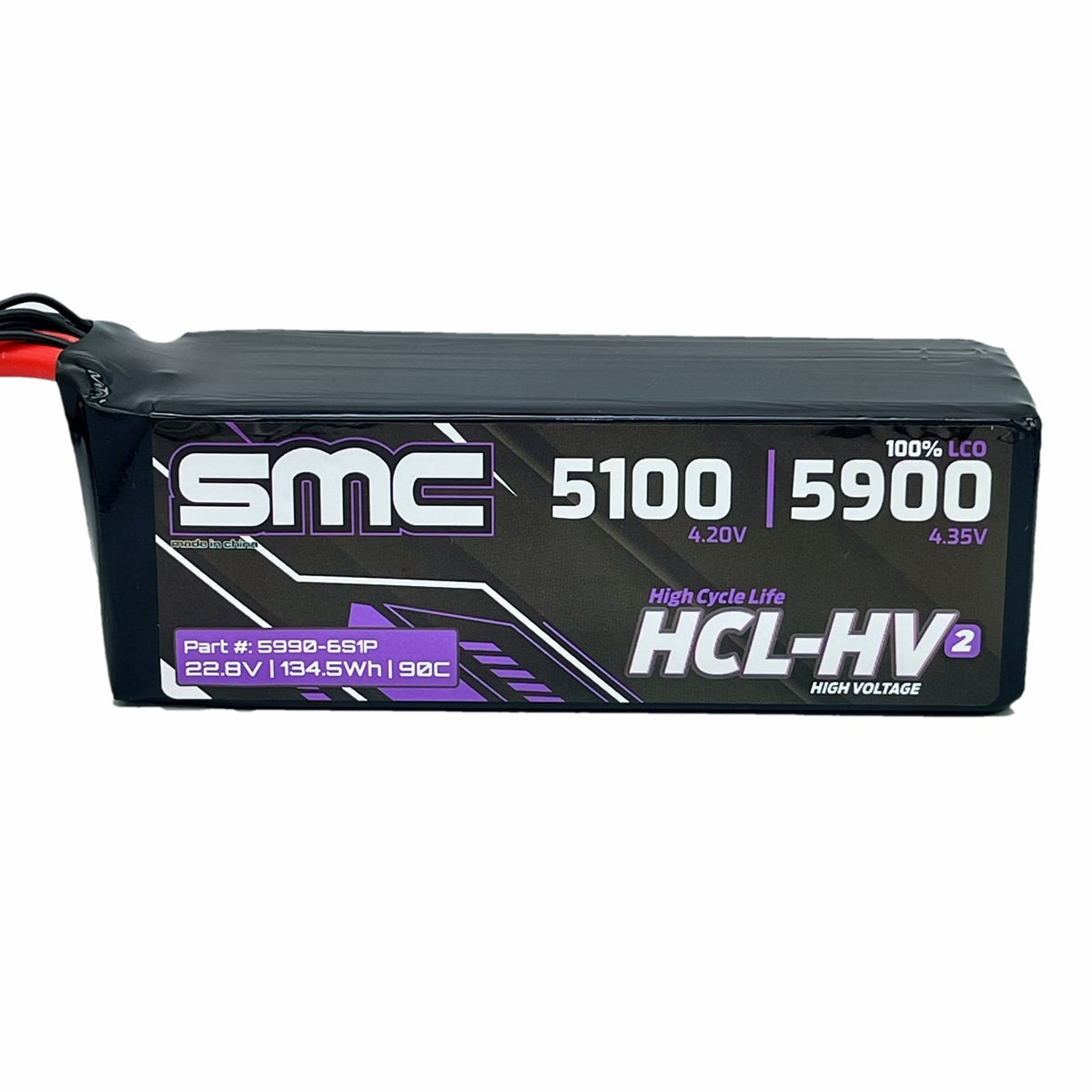SMC Racing
SMC-5990-6S1P HCL-HV2 Flight 22.8V/6S-5900mAh-90C EC5/SC5
SMC-5990-6S1P HCL-HV2 Flight 22.8V/6S-5900mAh-90C EC5/SC5
Couldn't load pickup availability
SMC-5990-6S1P HCL-HV2 Flight 22.8V/6S-5900mAh-90C EC5/SC5
By Purchasing This Product You Are Agreeing to the Following Purchaser Guide and Product Disclaimer. Please Read, LIHV Packs are not LIPO packs, and thus cannot be treated as such. You must watch cell voltages carefully to prevent overheating these packs which can result in permanent damage of these cells.
PURCHASER GUIDE & PRODUCT DISCLAIMER
SMC HCL-HV LiHV (4.35V) LiPo batteries are intended for users able to manage the requirements of high-power/low-weight extended flight packs. These are not your typical sport packs. They were specifically designed for use in high performance EDF and 3D RC aircraft. Thousands of SMC LiHV batteries have been sold to users experiencing years of robust, reliable, and long-term service. However, there have been purchasers unable to make the transition to higher power HV products from lower grade batteries. If the explanations below are unclear or too difficult to implement, SMC respectfully requests you instead review our 4.20V offerings. They also incorporate premium materials for the Cathode and Electrolyte providing increased performance over competitors without the need to deal with LiHV particulars.
LiHV batteries do not require special storage considerations. Long term storage is still around 3.80V-3.84V per cell and short-term storage as low as 3.70V is acceptable. Leaving any LiPo battery charged longer than 24 hours is NOT recommended.
Essential to using high performance HV products is understanding there is no free lunch. There are tradeoffs for the benefits and this document is intended to help clarify what they are. Requirements vary, so, a “big picture” understanding is necessary to identify potential pitfalls and determine if LiHVs are the right fit for you.
1. Over Temperature is the mortal enemy of all LiPo batteries. If you can't grip your battery tightly for 30 seconds immediately after a flight, odds are you have damaged it; at the least, it's cost a few cycles in the overall battery life. If it's too hot to handle, you've utilized the product incorrectly and damage has certainly occurred. Either figure out how to address the issue in a way which provides you with an acceptable flight or LiHV is not for you.
2. By definition, LiHVs use a higher voltage gradient to produce power. This allows a lighter weight pack to often deliver more mAh's than a heavier 4.20V pack. Weight savings as high as 1/4 lb per pack are not uncommon. Active throttle management becomes more of a necessity as not only do LiHVs generally have less mass than the non-HV equivalent, but they also deliver a higher rate of power output over a relatively longer period. Basically, lower mass combined with higher power output results in potentially higher temperatures if use is not managed properly.
3. Poor Voltage Management is the real cause of overheating. It is a common misconception excessive load is the cause; it is not. Regardless of the type, real C rating, or size, if you never allow your LiPo to go below 3.56V/cell under load, you will never overheat it. This is a fundamental fact established conclusively over many thousands of load testing cycles under controlled and monitored conditions.
4. High performance LiHVs can mask low voltage operation. They can perform at high levels as they're being destroyed. Some RC pilots are not aware of how much additional power it takes to increase velocity by a few MPH. Craft aerodynamically designed for speed can consume up to 30% more power to add just 10 MPH. Foamies often have “features” like cheaters, uneven surfaces, and wheel pockets which impede velocity increase even more so. A common trap is that throttle setups are seldom linear. What looks like “75%” is often really closer to 90% power. So, where a sport grade pack might be delivering a lower power output, a high performance LiHV can be pumping more power through a setup unable to increase the velocity of the craft by much. The LiHV battery thus depletes its capacity at a higher-than-expected rate and gets hotter, so the user is left thinking there's something wrong with the battery.
For first time customers/users, it is recommended to purchase one or two packs and see how they perform and hold up under the intended usage. If they don't expand/swell and the performance holds up for many cycles, more batteries can be ordered. If they don't hold up, please buy our HCL-HP non-HV flight packs.
In the fall of 2022 we released the HCL-HV flight series which were the first high performance LiHV packs that out performed high performance 4.20V packs by using the latest and greatest in materials. This is validated by 3rd party testing which you can check out HERE. We are proud to offer the new HCL-HV2 series where we've been able to increase the C rate with a slight increase in mAh per gram. Typically when you improve the C rate this comes at the expense of mAh per gram which is why we are proud of what we accomplished with this new series. The result is a boost in voltage under load with a bit more mAh per gram.
- True mAh +/- 5%: 5900mAh
- Voltage: 22.8V/6S
- Power Factor: TBD For more information click here
- Size: 49mm x 50mm x 150mm G10 bottom & top plates.
- Weight +/- 10gr: 750gr
- Wire size: 10AWG
Charge rate: 1C to 5C- please note that a higher charge rate will put less mAh into the pack and will reduce cycle life
- please note that a higher charge rate will put less mAh into the pack and will reduce cycle life
Share



